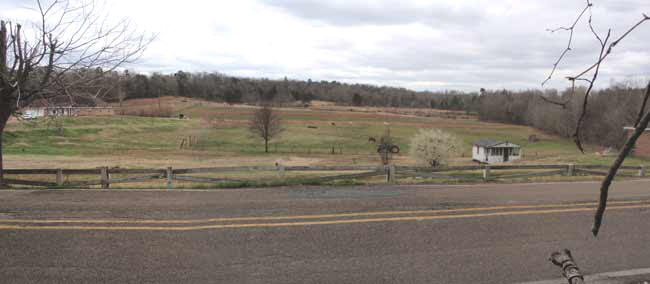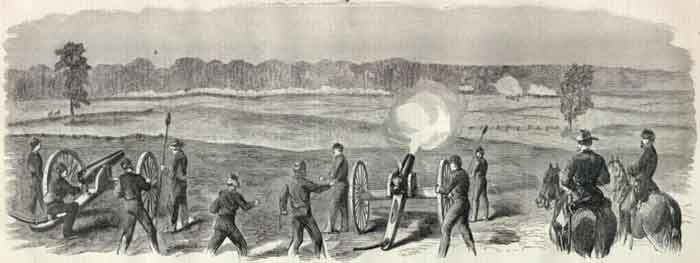Fighting For
Vicksburg
By B. F. Boring
The two armies camped on the night of May 15 in close proximity. The pickets were very active, and their firing was brisk all night, and as the dawn of the 16th approached, clear and hot, the clatter of the picket-line soon swelled into the road of the battle. We were now fighting a new foe, Pemberton instead of Johnston, with Johnston somewhere in our rear, likely at any moment to open upon us. It soon developed that that the heat of the battle was to the left of us, and in front of Gen. Hovey’s Division. Our part of the line seemed to monkey or maneuver all forenoon, and finally took position in an open cornfield, on a sloping, sandy hillside, where the burning rays of a Mississippi sun had a fair sweep at us. Here we lay down and spread out, and were lulled to sleep by the sweet songs of rebel bullets as they hummed like honey bees through the air overhead, and occasionally fell in front of us, knocking sand in our eyes, interrupting our slumbers and disturbing our dreams of flowing brooks and gurgling springs of clear, cold water. Presently a fine brass battery came tearing into the field in our rear, with their six cannon, 12 wagons, and 48 fine horses, with the racket and animation of a city fire department turning out to a conflagration; unlimbered, wheeled, into position went the horses and baggage away out of range, and began to poke it to the Johnnies in the woods beyond an old rail fence in front of us as they meant to hurt. The cannonade was so low and close to us here that it was very uncomfortable, the passing shot and shell causing dizziness and vomitting to the men lying in line so close to the guns; also, the lead butts to the pointed percussion shell, to make them fit the rifles of the cannon, would fly off us soon as the shell left the muzzle of the gun, and often struck, melting hot, in our line, more to be dreaded then the shell itself. After a cannon has been used a while in active and close firing, it becomes sloppy from the condensation of powder, and this black, offensive slop, scalding hot, splattered on us, adding to our discomfiture from our own guns. We had a memorable experience while lying here in support of the battery. “The half will ne’er be told.” I remember a fellow in my company by the name of Alf Perkins, the fun maker for his comrades. Alf was carrying a long-handled frying pan that day, and while lying here he stuck the end of his pan-handle in the ground, and used the pan as his breastworks, keeping his head behind it, and peeping around it. When a bullet would whistle close he would yell out: “A little higher, if you please.” “A little more to the left, please;” or “A little further to the right,” etc. After a while an Orderly or Aid came riding up to our Colonel and said something to him. The Colonel said in a loud voice, as all could hear: “Attention, 30th! — Forward!” Of course we got up, but did not stand quite erect, and advanced across the field to the old fence at the edge of the woods in rather, a stooping posture. Here Capt. Meily received his mortal shot, leaving us without a commander. Looking back I saw Alf Perkins lying dead on his face in the plowed ground, among the green earth. I can never forget how pitiful he looked lying there dead with his frying pan in his hand. The Johnnies seeing us coming very politely took back --- and gave us their position. And to this day, when the old comrades meet who were in this charge at Champion Hills, and get to talking about the fight, one of the first question is: “Do you remember the advance to the old rail fence?” This was the worst ---- we took during the battle, and deprived us of all our company officers down to Third Serg’t Issac Mann, who took command of the remnant of the company. The position at the old rail fence was held during the remainder of the day, although we received several round of grape and canister-shot mixed with slivers and splinters of old rails from the fence in front of us. The firing ceased with nightfall and Pemberton’s retreat from the field. I remember that my regiment evacuated the old fence about dark, marched a short distance over a ridge or hill, and went into camp or lay down on the ground along the road for the night.
The scene is near the the 30th Illinois' location at the beginning of the battle.
|
| Home | Grant's March | Pemberton's March | Battle of Champion Hill | Order of Battle | Diaries & Accounts | Official Records | | History | Re-enactments | Book Store | Battlefield Tour | Visitors | Copyright (c) James and Rebecca Drake, 1998 - 2010. All Rights Reserved. |

